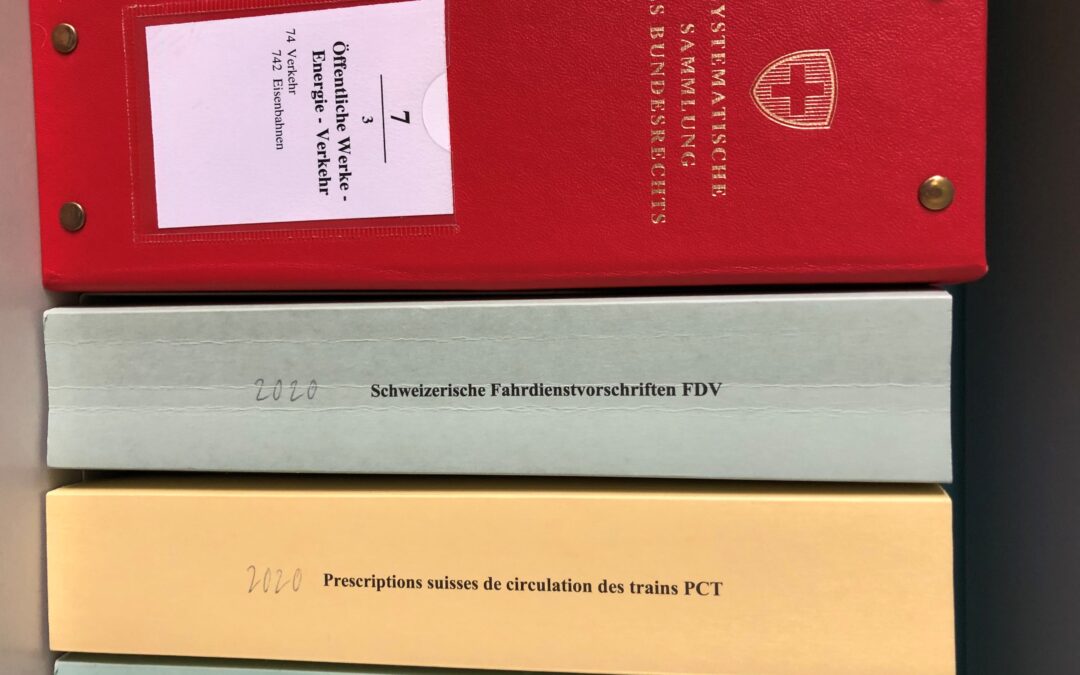The Federal Office of Transport (FOT) is further developing the Swiss Driving Service Regulations (FDV2024) as part of the 2024 amendment cycle. Systematic changes are central. Here is a statement from the perspective of the shipping industry.
This is what it’s all about:
- Further development of the driving service regulations from 2024 in force
- Systemic simplification for railway employees required
- Consistent application of the TSI OPE additionally increases interoperability
- Railway industry should take responsibility for the rules on driving services
- VAP wants more entrepreneurial leeway for siding operators
For more than 20 years, uniform train service regulations have been in force in Switzerland, which are binding for all railway undertakings. They are essential for railway operations, as they define safety-relevant activities and cooperation measures and specify the tasks, competences and responsibilities of all those involved in railway operations. The FOT works closely with the railway industry to further develop the driving service regulations and update them every four years. This amendment cycle makes sense, as it takes into account both the daily experiences from operations and the technical developments in the railway industry. However, it also has negative side effects: For example, the TSO have grown into a jungle of regulations that is difficult to keep track of and that urgently needs to be streamlined and aligned with the interoperability regulations. The responsible companies must be granted more entrepreneurial freedom. The current revision is scheduled to come into force on 1 July 2024[1]
Amendment cycle 2024 with important sub-projects
We at the VAP welcome the systematic further developments of the driving service regulations proposed by the FOT in the conceptual sub-projects (cf. Figure 1). We also suggest that the fundamental innovations be implemented consistently and quickly.

- With sub-project 1 “STRUCTURE”, the FOT wants to systematically structure the driving service regulations in order to make them more comprehensible and uniform for users. The full implementation of this unification will require several rounds of amendments. It usually makes sense to combine structural harmonisation with material adjustments.
- With sub-projects 2a, 2b and 2c “Application”, the FOT aims to create the conditions for a systematic digital use of the driving service regulations. Each individual regulation is assigned to a scope of application or an option. It is now specified who performs which function. As soon as this sub-project is realised, regulations can be clearly filtered according to areas of application and assigned to functions. This will massively increase efficiency in the creation and in all applications of regulations, as it allows for digital usage options.
- Within the framework of sub-project 3 “Impact”, the FOT is required to find a user-friendly strategy to ensure the safe transfer of responsibility to the railway undertakings during ongoing operations. According to TSI OPE (see box), the railway undertakings are responsible for operating regulations; this should also apply in Switzerland in the future. The ongoing development of the TSI OPE will also make it possible to gradually abolish the existing national rules of the rolling stock regulations and to retain only mandatory national regulations that have to be notified to the European Railway Agency ERA as Notified National Technical Regulations (NNTV)[2].
- Sub-project 4 “MATERIAL” includes a number of content-related adaptations that update the running service regulations.
Regulating cooperation between all stakeholders
Far-reaching changes are on the horizon for the further development of the driving service regulations as of 2024. We are convinced that railway operations cannot be classified as complex per se. It needs clear rules for the cooperation of all those involved – especially because the division of labour, automation and specialisation in railway operations are increasing. Therefore, in our view, the following aspects should be included:
Aim for simplification
There is a need for uniform, comprehensible and addressee-appropriate regulations that apply across companies. Employees should have all the necessary rules for their respective functions and be able to work consistently freed from unnecessary ballast.
The operating regulations should be formulated on a risk basis, and the railway companies must develop simple and cost-effective solutions tailored to them within a defined overall framework in order to produce competitively.
Use digitalisation
With function-based filters, digitalisation enables a massive increase in efficiency in the use of the driving service regulations. Anyone carrying out a safety-relevant activity needs to know the regulations relevant to it – but only these.
Ensuring entrepreneurial freedoms
We at the VAP strive for feasible solutions for sidings, as strict compliance with the regulations defined for railway operations is not always possible here. For sidings in particular, we recommend a risk-based approach to ensure more entrepreneurial freedom. Specific regulations are needed to make the operation of sidings safe and cost-efficient for operating companies and employees.
Ensure interoperability
Interoperable railways that operate on different infrastructures and across borders in several countries have different requirements than regional railways and railway sidings that only operate locally. In view of the different conditions at stations and sidings, the operating regulations must be designed differently, comprehensibly and concentrated on the essentials within the framework of a uniform overall structure, depending on the traffic and infrastructure.
In the standard gauge sector, the operating regulations are becoming increasingly harmonised internationally with the further development of the TSI OPE. The number of remaining national regulations must be kept to a minimum in order to improve practical applicability. All countries involved are required to abolish national regulations that are no longer needed. Consistent application of the OPE TSI will lead to more uniform rules in cross-border traffic in the long term and to the gradual disappearance of hurdles.
Assume responsibility
The OPE TSI assigns responsibility for the operating regulations to the railway undertakings. Consequently, the FOT must hand over its sovereignty over the operating regulations to the railway industry. The Swiss railway industry should actively assume responsibility for the entire operating regulations and their further development. The VAP welcomes this transfer of responsibility of the FDV to the railway industry. It is to be combined with the upcoming innovation steps. In the railway sector, a cross-company solution for uniform overarching operating regulations must be found. From the point of view of the VAP, a cooperative collaboration model would be appropriate, in which the FOT has the coordination task and develops and agrees on operational regulations in the form of a guideline together with the technical experts of the railway industry (thus Art. 3a GüTV according to the draft of the Federal Council of 2 November 2022). After publication, these guidelines can be used by the individual companies for the preparation of their driving service regulations.
| TSI OPE 2019/773 This abbreviation stands for the European Union’s implementing regulation on the Technical Specifications for Interoperability “Traffic Operation and Management”, issued in 2019. According to this regulation, rail should regain market share thanks to barrier-free train journeys across national borders and contribute to the reduction of CO2 emissions. This requires, among other things, a comprehensive Europe-wide harmonisation of operating rules. Until now, different national regulations have been applied in different countries. The EU is driving harmonisation forward with the further development of the OPE TSI. In it, it defines the responsibilities for companies, but does not provide for any officially issued driving service regulations, as is currently the case in Switzerland. This remains the responsibility of the railway undertakings. In the interests of interoperability, they must adapt the service regulations to the requirements of the OPE TSI. Switzerland has also committed itself to the application of the OPE TSI via the Joint Committee (CH-EU land transport agreement). |
Sporty timetable
The FOT has published the following timetable for the further development of the driving service regulations:
| Implementation step | Deadline |
| Publication of FDV2024 | by the end of November 2023 |
| Entry into force of FDV2024 | 1 July 2024 |
| Intermediate cycle FDV2025 (Tram and TSI OPE sub-projects) |
at the end of 2025 |
| Next regular cycle | as of mid-2028 |
[1] https://www.bav.admin.ch/bav/de/home/publikationen/vernehmlassungen/abgeschlossene-vernehmlassungen/weiterentwicklung-fdv-a2024.html
[2] https://www.bav.admin.ch/bav/de/home/rechtliches/rechtsgrundlagen-vorschriften/nntv.html



